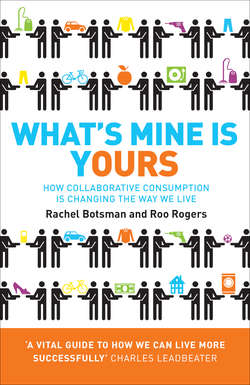What’s Mine Is Yours: How Collaborative Consumption is Changing the Way We Live

Реклама. ООО «ЛитРес», ИНН: 7719571260.
Отрывок из книги
In October 2007, designers from all over the world travelled to San Francisco to attend the annual industrial design conference. The city’s hotel rooms had been sold out for months. Joe Gebbia and Brian Chesky, old friends and graduates from the Rhode Island School of Design, were among the ten thousand people planning to attend. The classmates had recently moved into a big loft in South of Market, San Francisco, or SoMa, as it is known, to start a business. During a conversation Gebbia and Chesky had about making some quick money to help pay their rent, they asked themselves, ‘Why not rent our extra room and advertise it on the conference website?’ They did, and made close to $1,000 in just one week.
Chesky and Gebbia thought that people in their twenties would respond to their offer. Three people ended up staying: a male designer from India who read about the idea on a local design blog and who saw it as a great way to meet new people; a thirty-five-year-old woman from Boston who thought it was better value than a hotel; and a forty-five-year-old father of five from Utah. ‘It completely blew away our assumptions,’ Gebbia recalls. The friends were also surprised that they didn’t feel like they had strangers in their own home. ‘They are strangers until you have a conversation with them,’ Chesky explained.
.....
The results were clear. Students who agreed to pay with cash bid an average of $28.51 for the Celtics ticket, but the students who agreed to pay with plastic bid an average of $60.24 – an incredible 113 percent premium over the cash bids. The outcome for the Red Sox tickets showed the same pattern, but the price premium for credit card bids over cash was lower, at 76 percent, perhaps because these seats were not as desired or rare. Were the students who bid with credit cards less able to constrain their desire and more reckless with their bidding? And given that the bids were for items of an uncertain value, how much does this experiment apply to the world of goods with a price tag?
Dilip Soman, a marketing professor at the Hong Kong University of Science and Technology, designed a study to look at this very point. Soman intercepted forty-one students after they had made purchases at the campus bookstore and asked them to recall the exact amount they had spent. Of the respondents who had paid by credit card, only 35 percent could recall the amount; the remainder either named a figure far lower than the true amount or confessed that they had no idea.[80]
.....